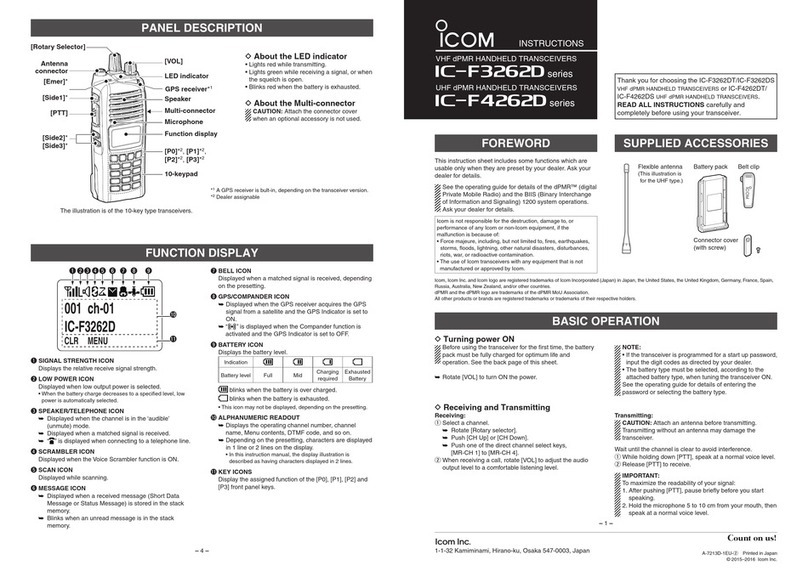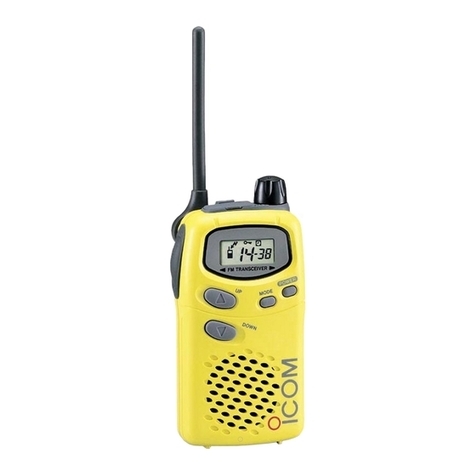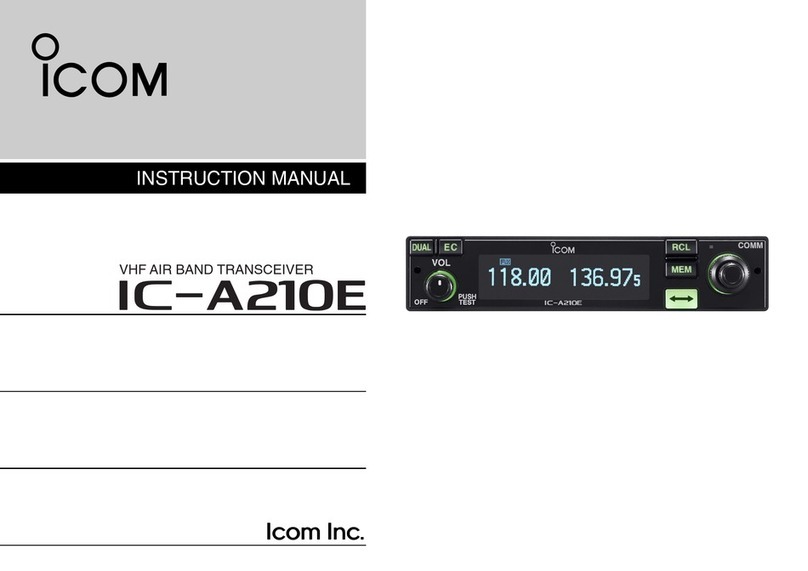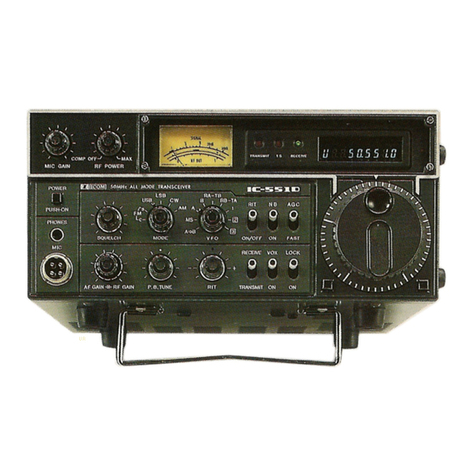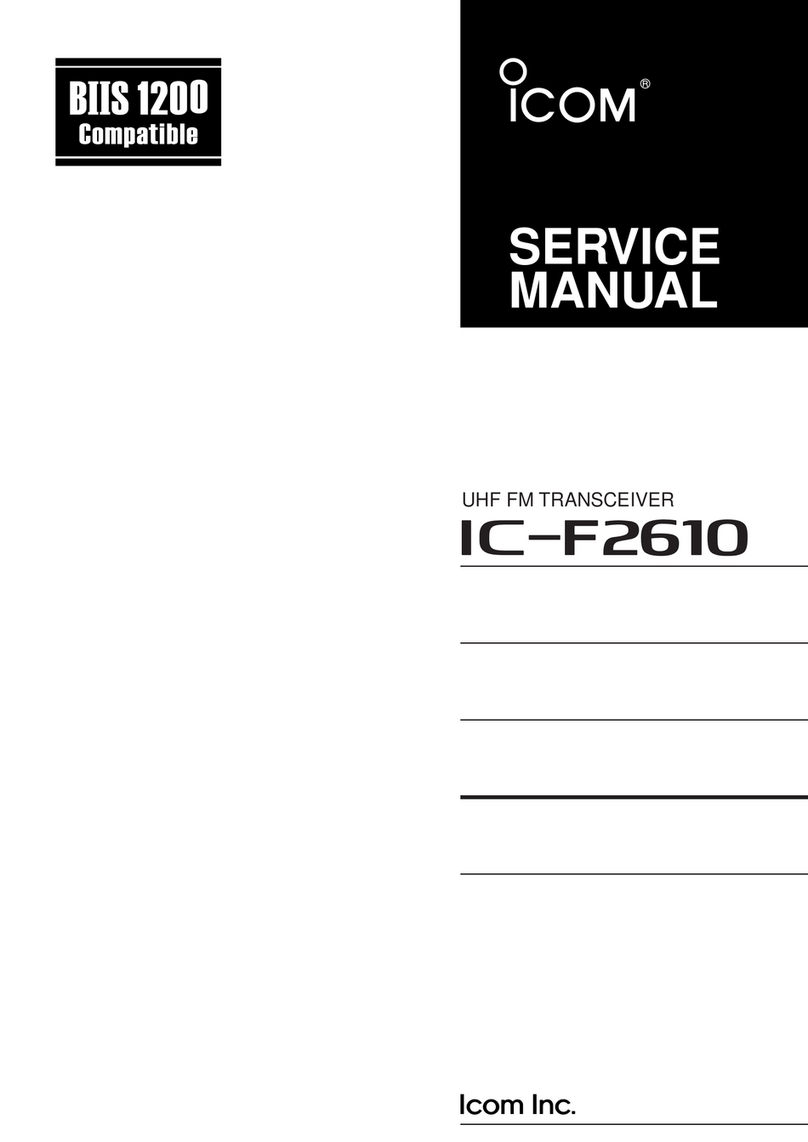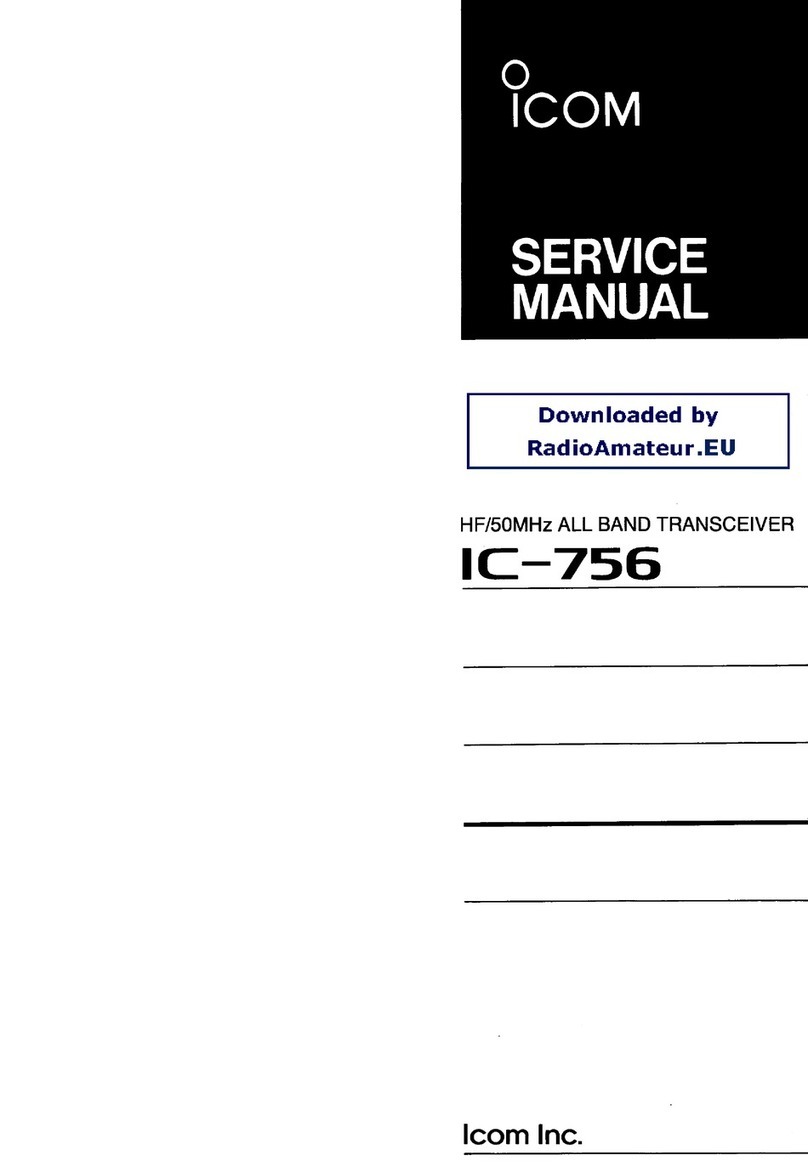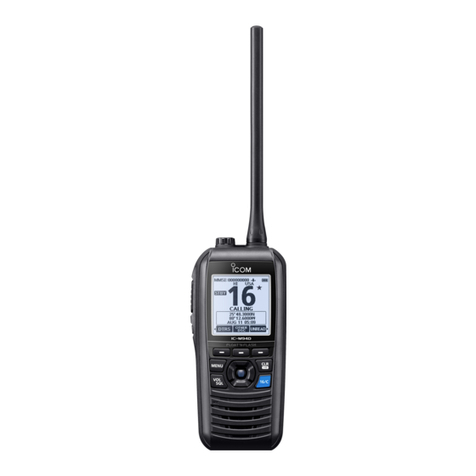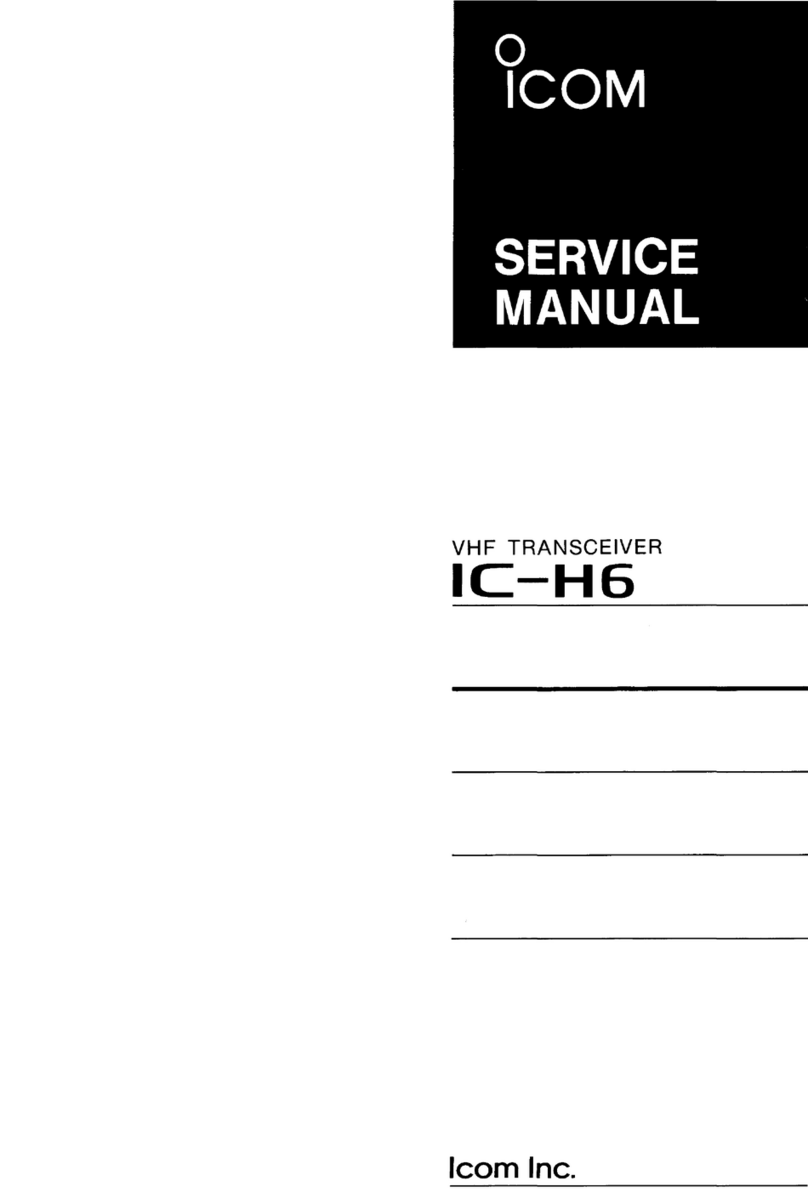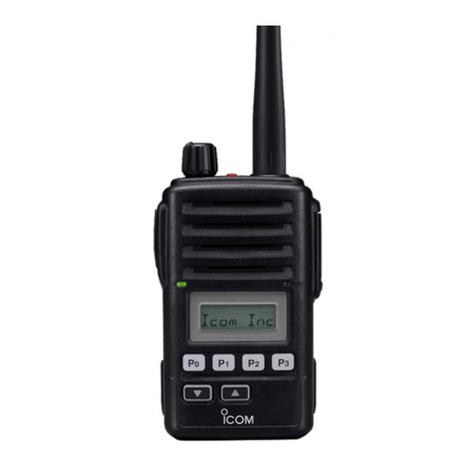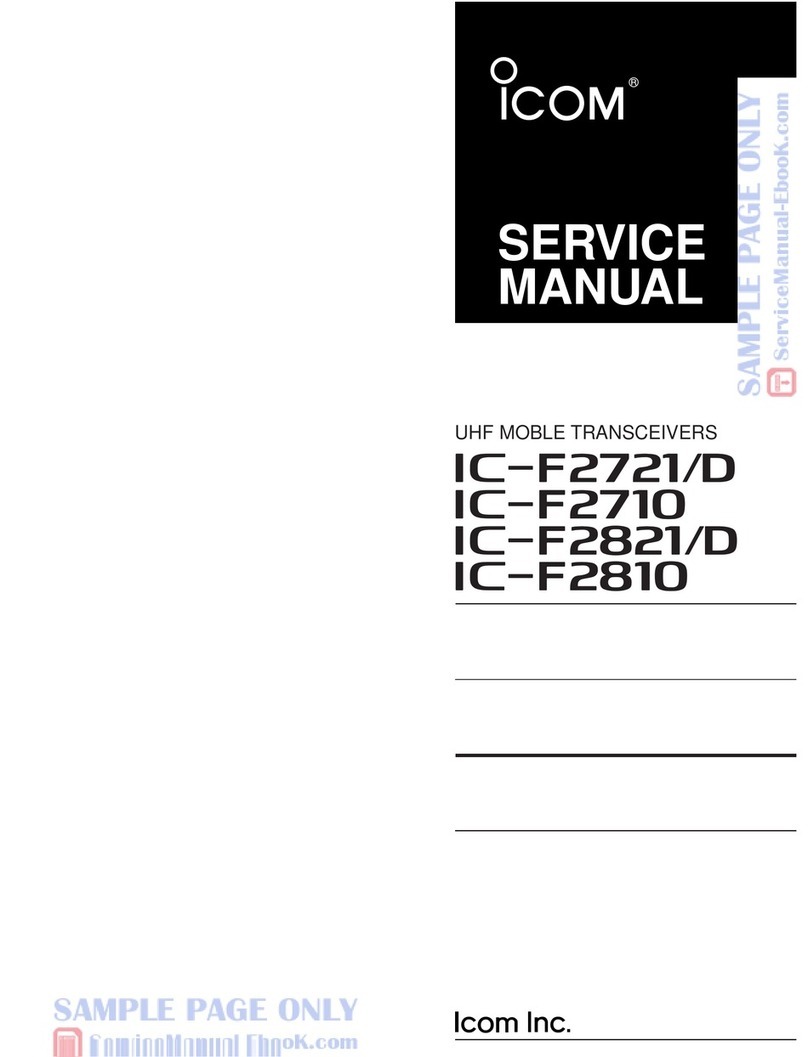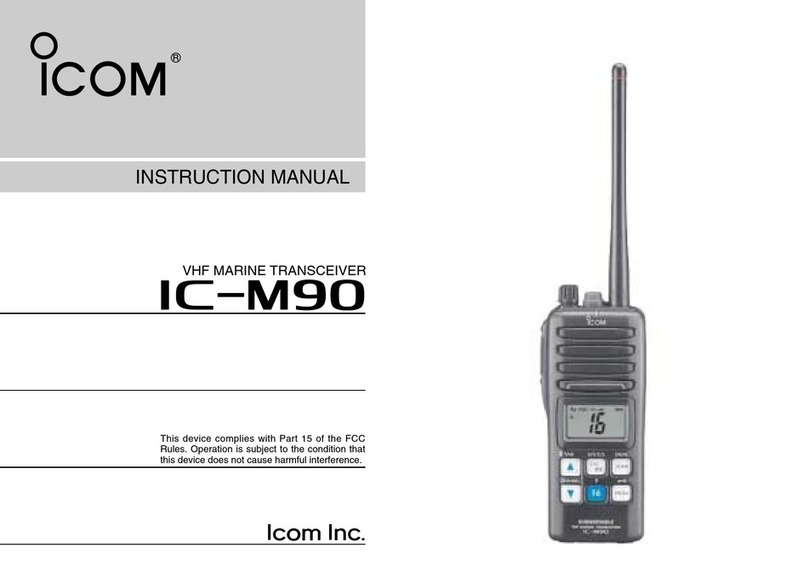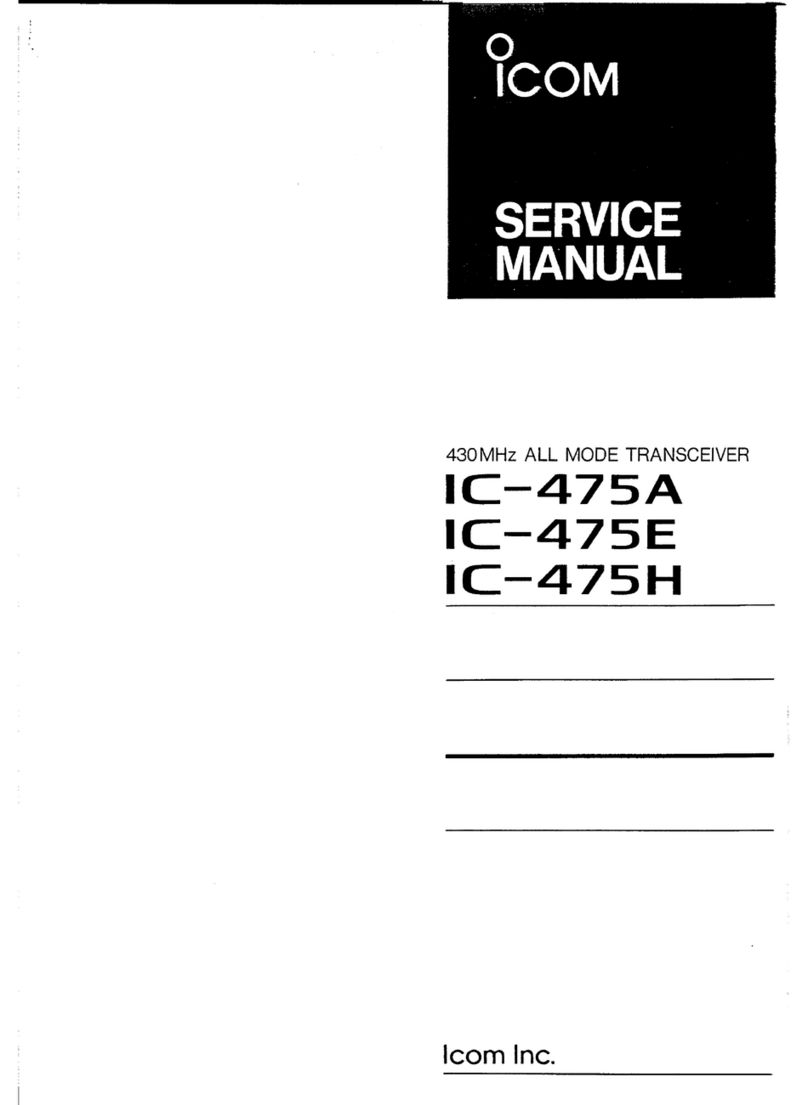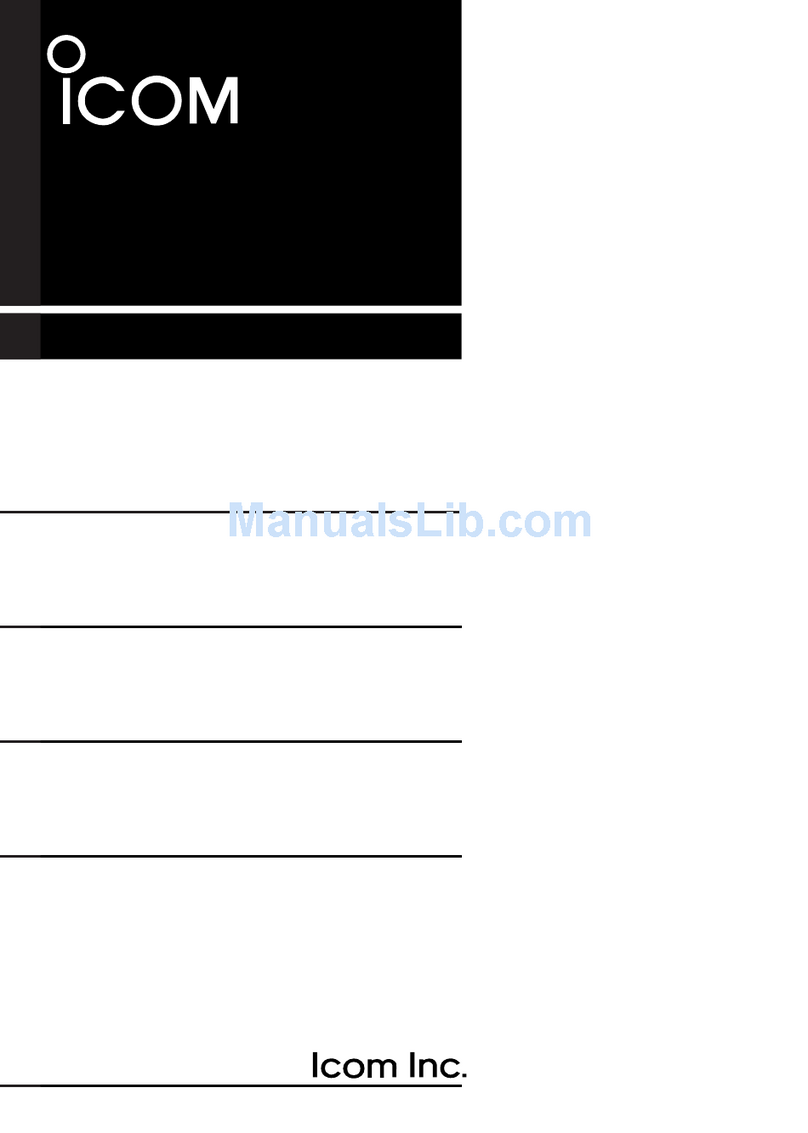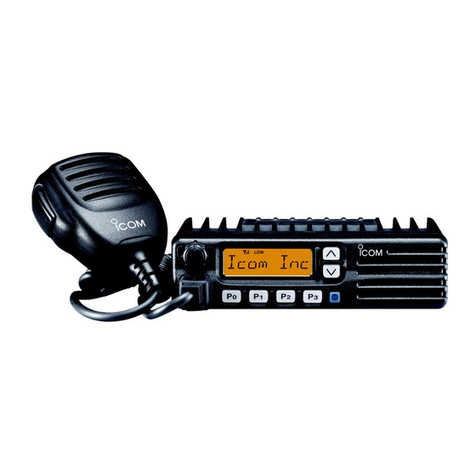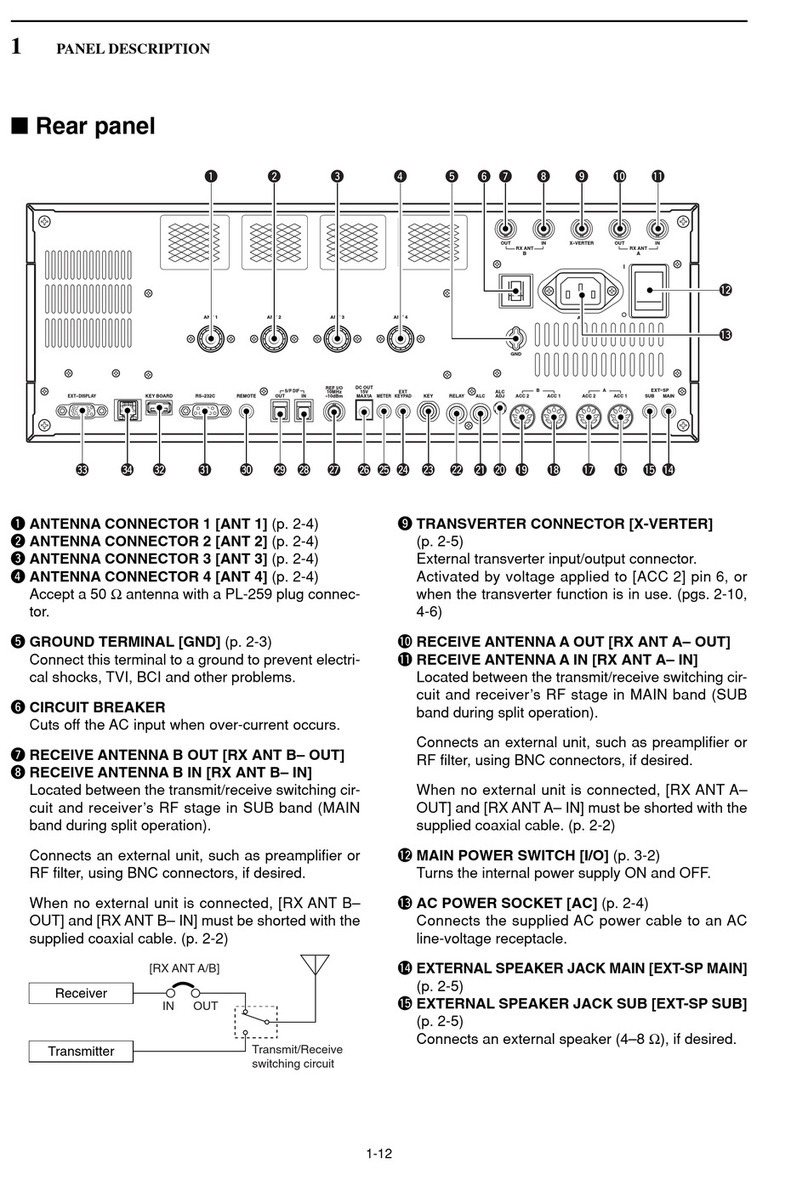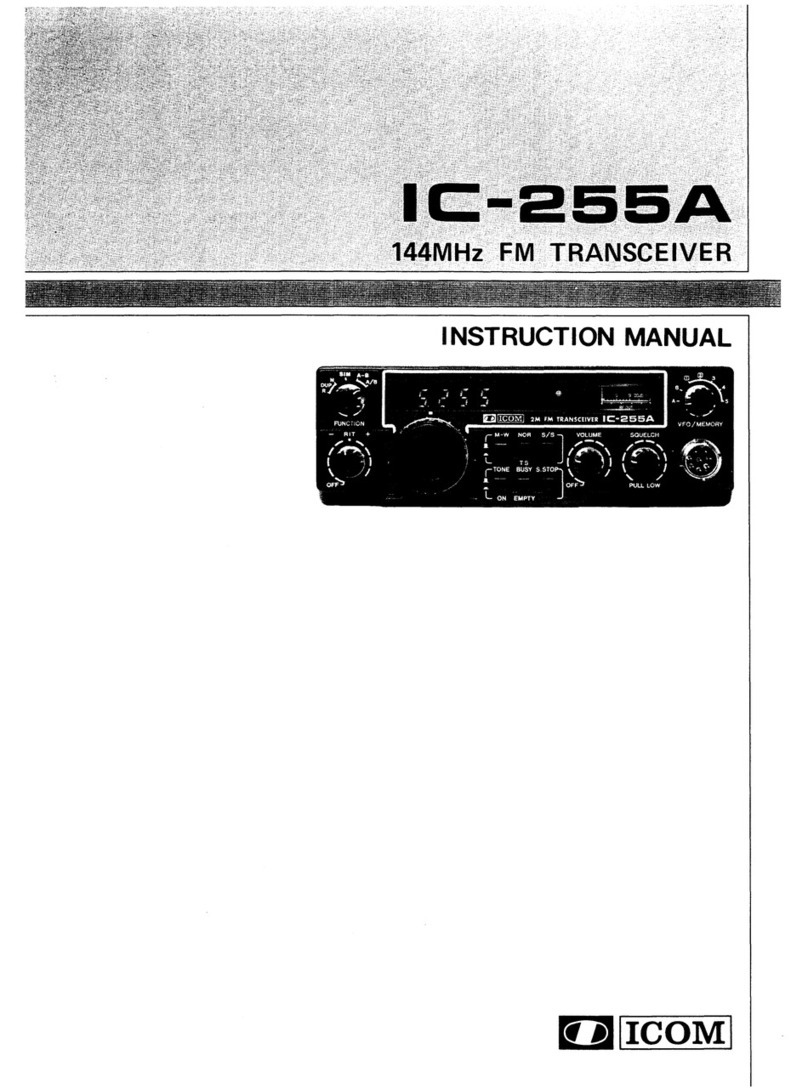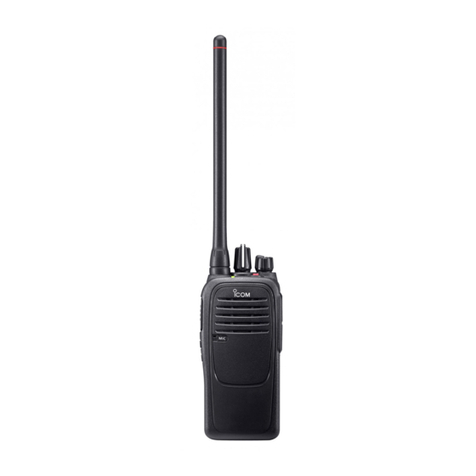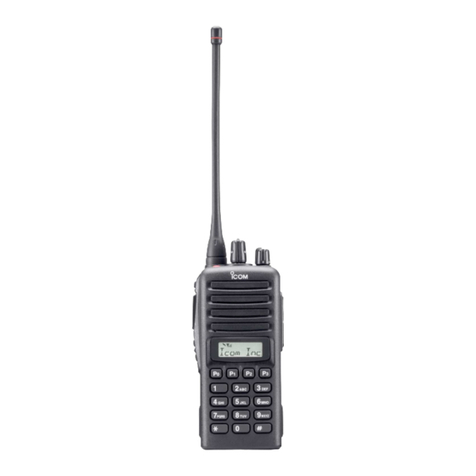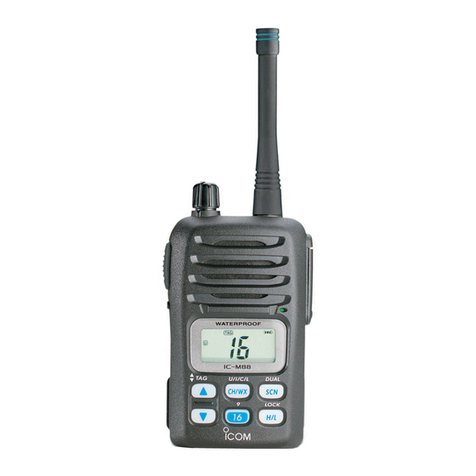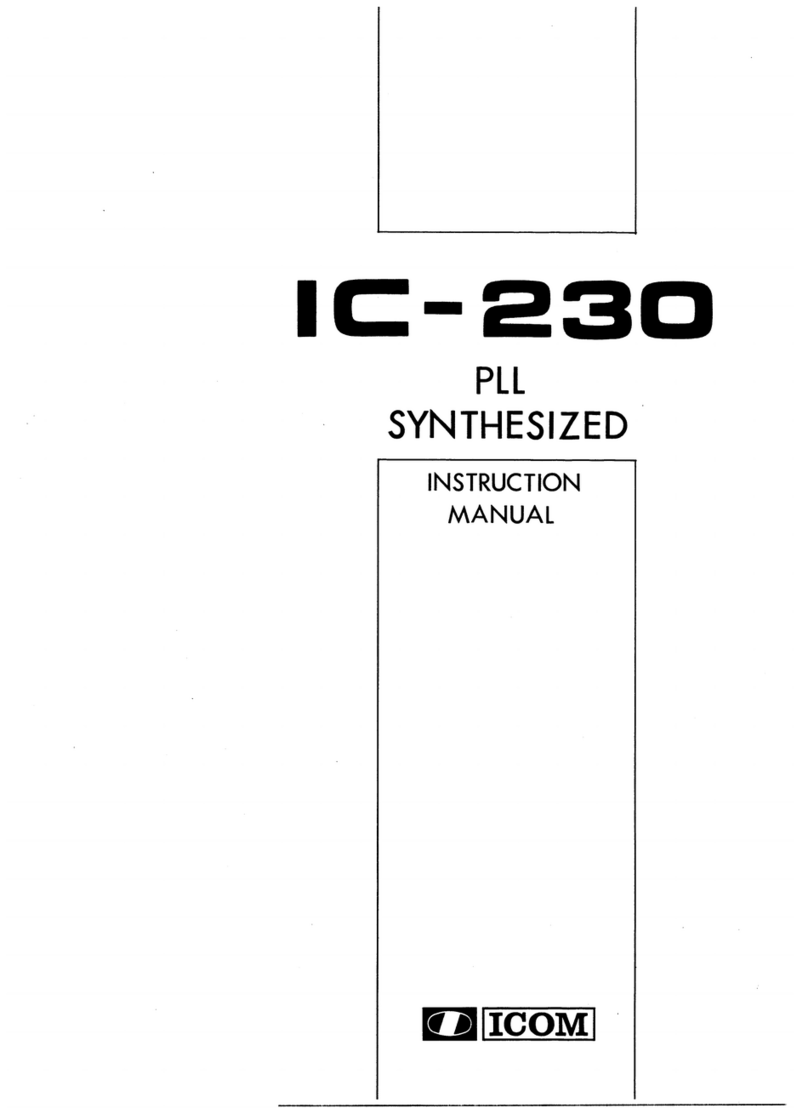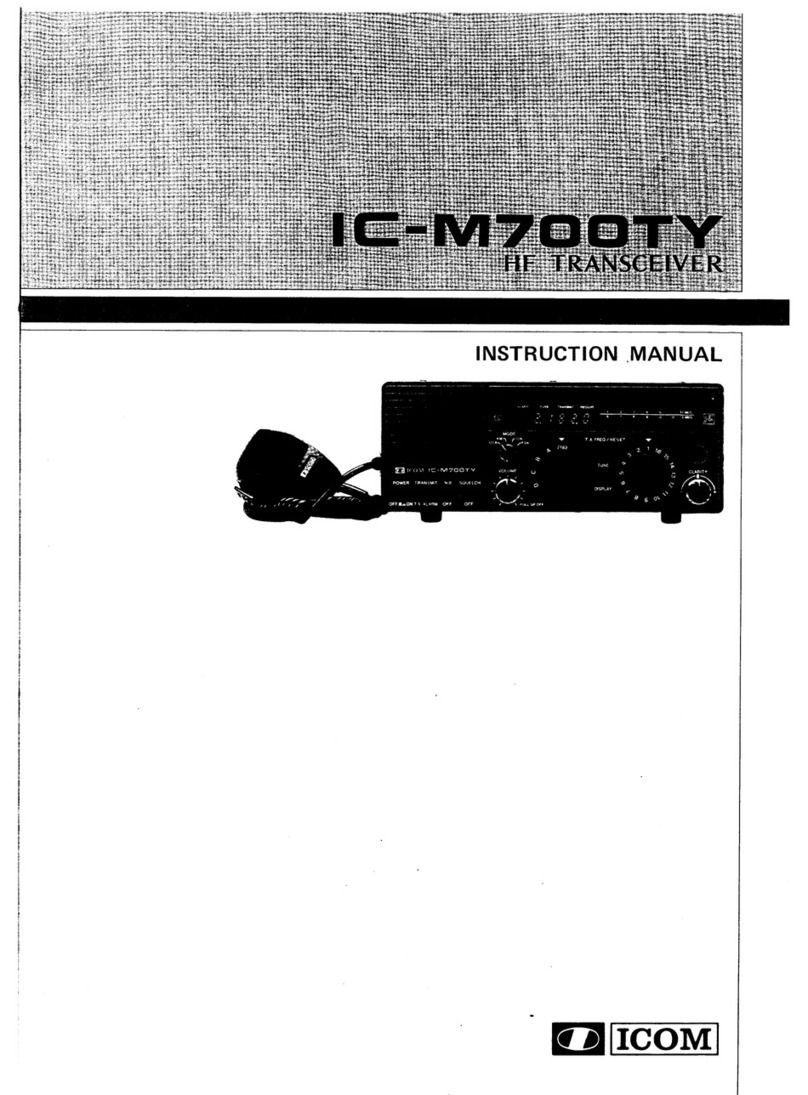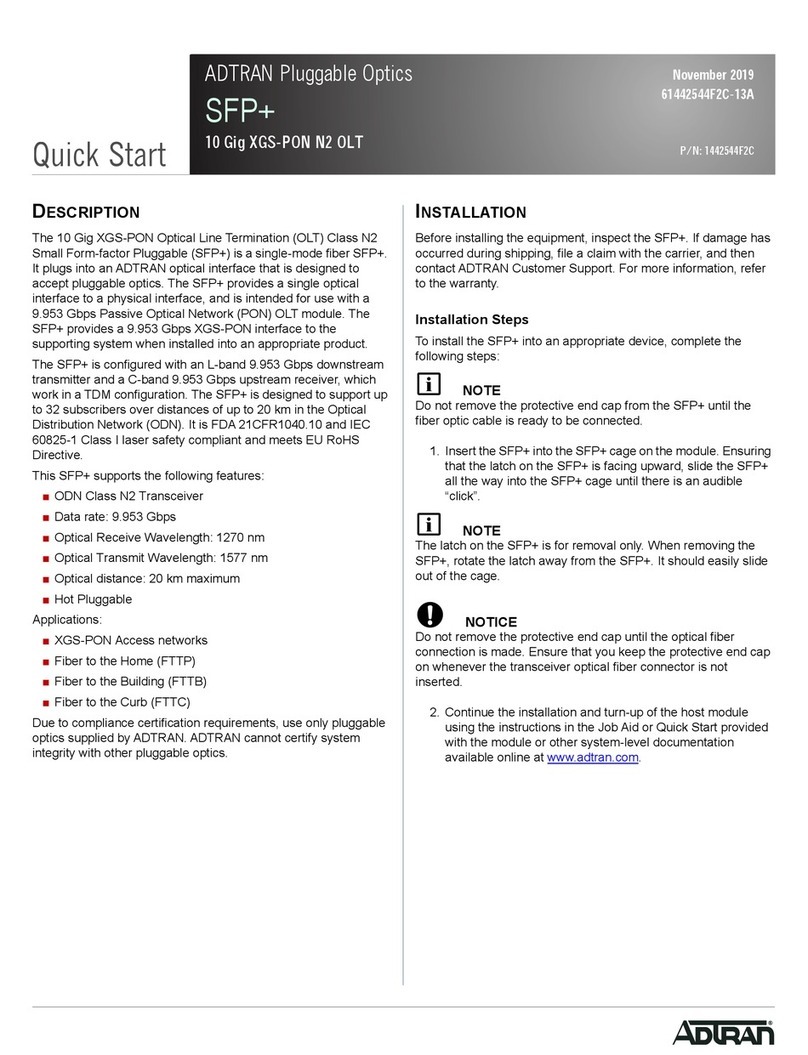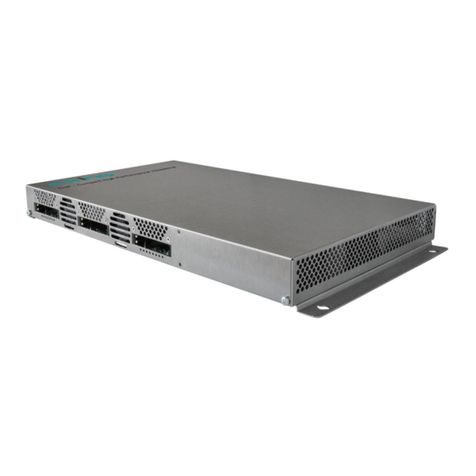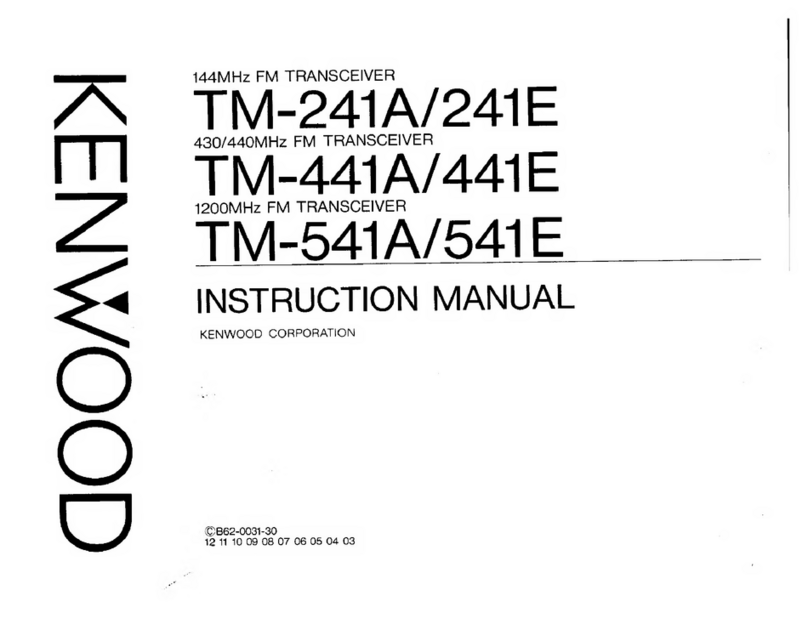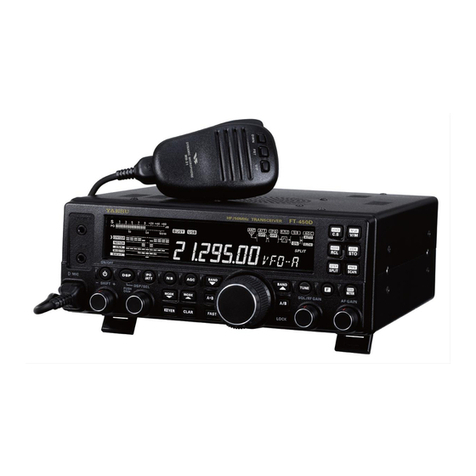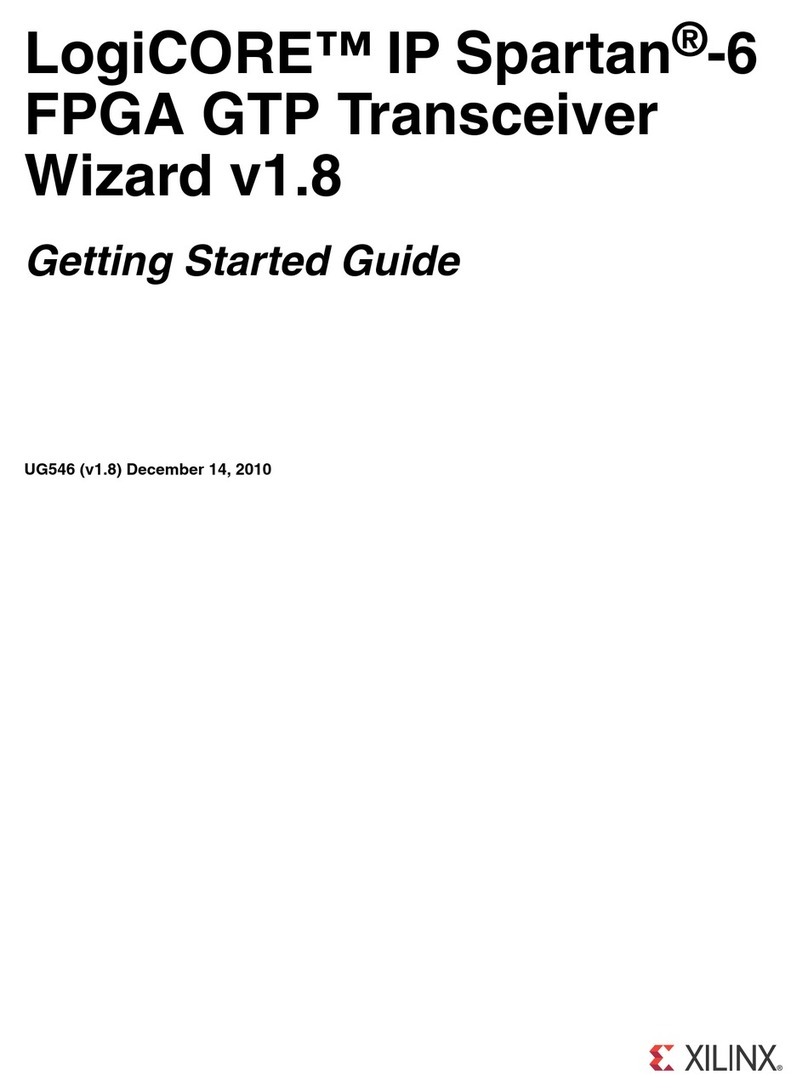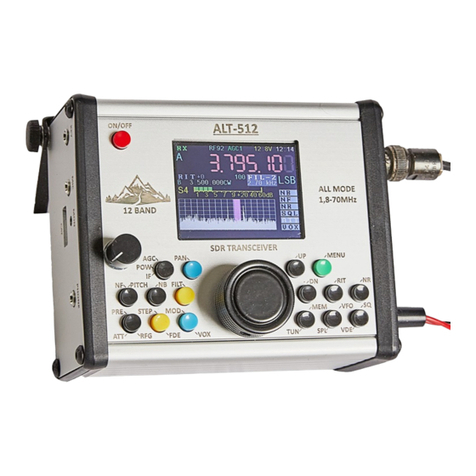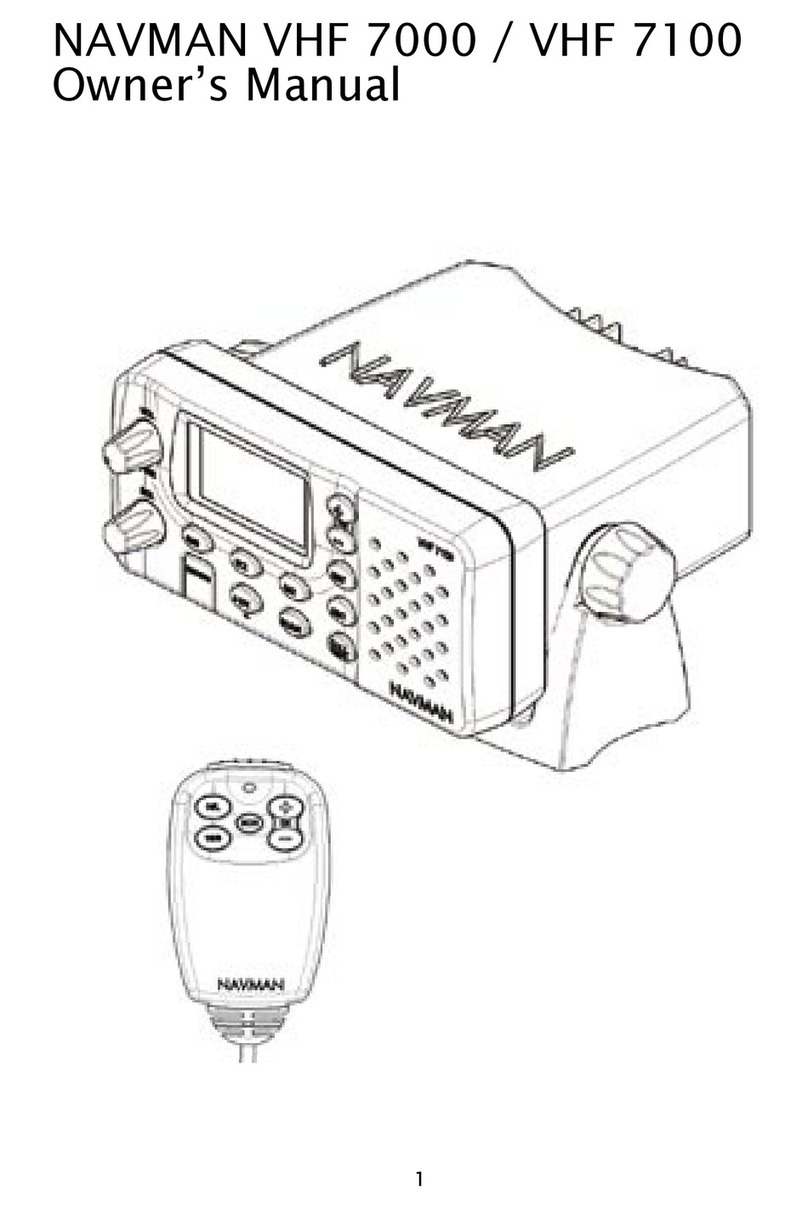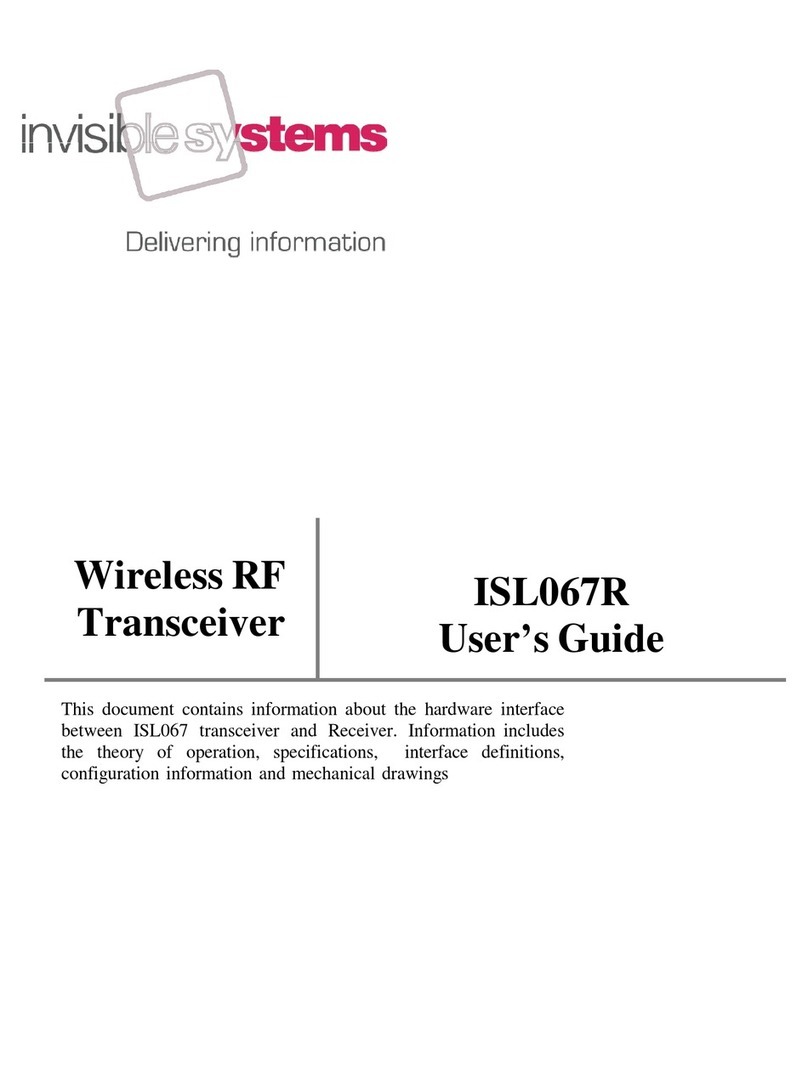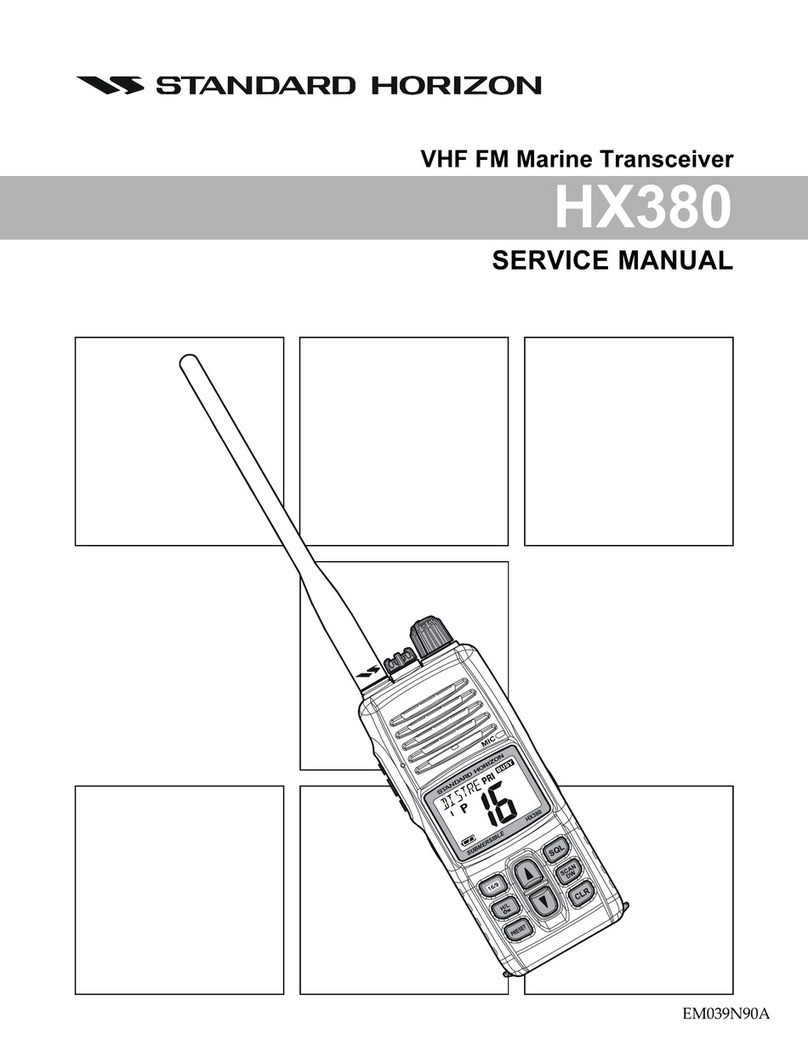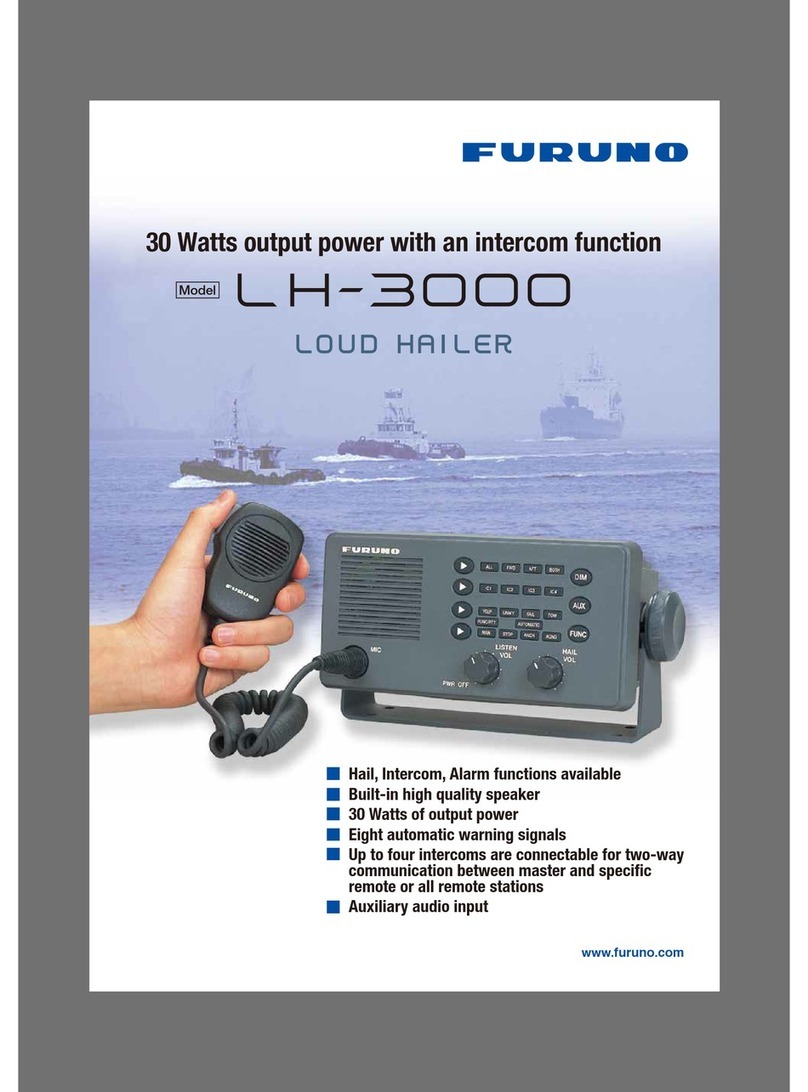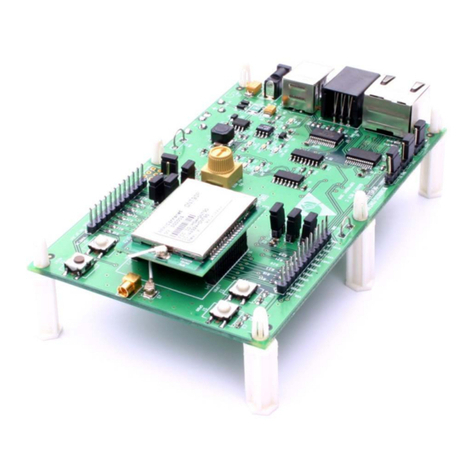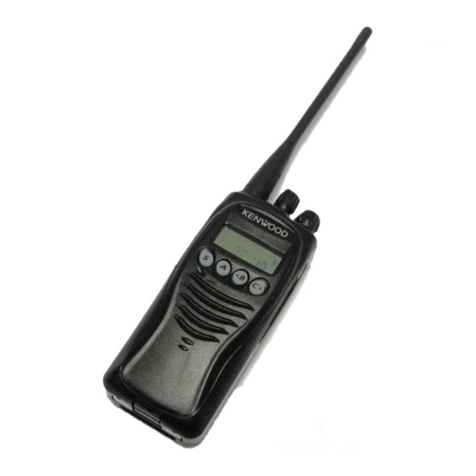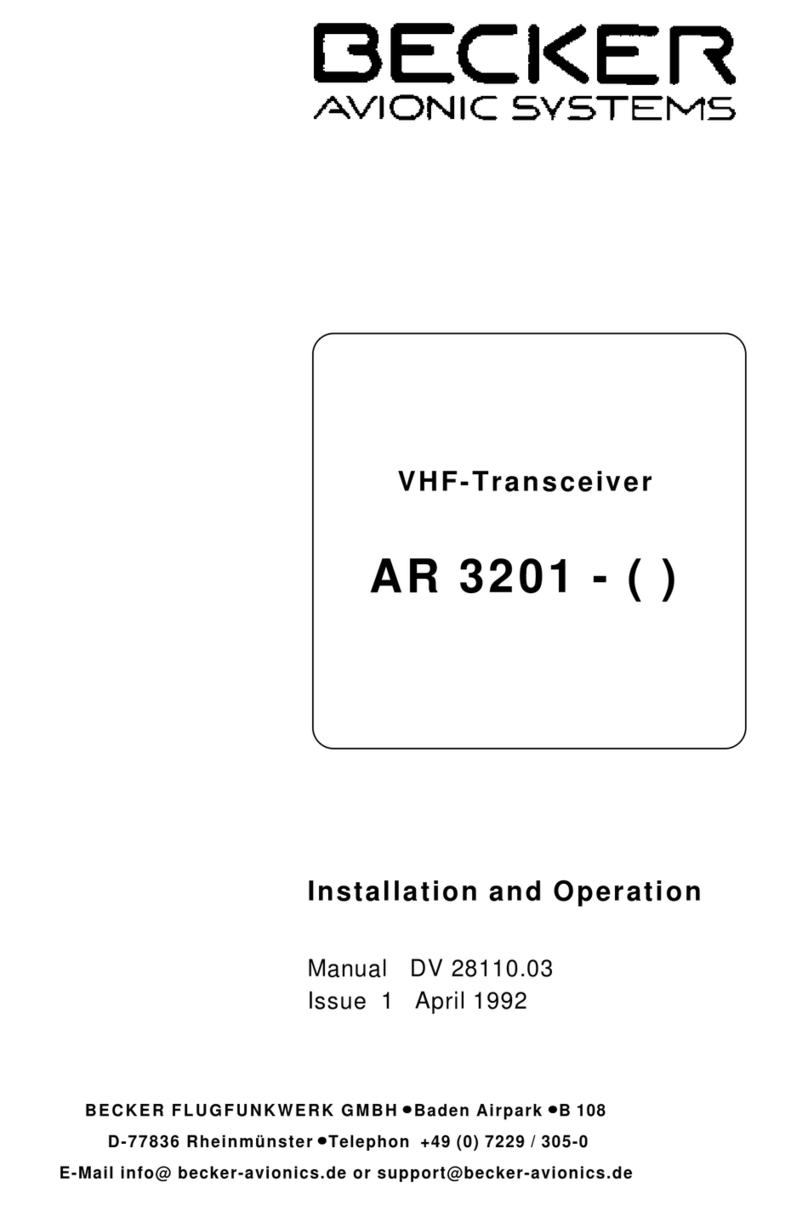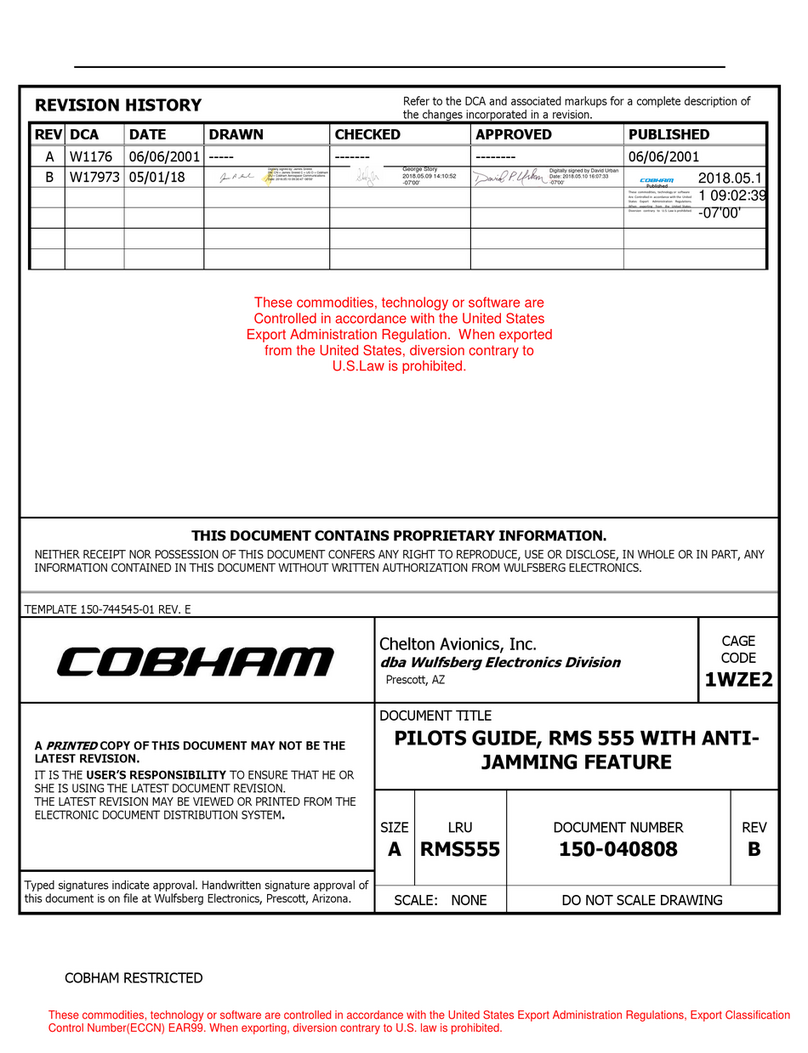Icom IC-F30 User manual

o
ICOM
INSTRUCTION MANUAL
VHF TRANSCEIVER
IC-F30/LT
UHF TRANSCEIVER
IC-F40/LT
This device complies with Part
15
of
the
FCC
rules. Operation
is
subjecllo
the condition that this device does not
cause harmful interference.
Icom Inc.

IMPORTANT
READ
ALL
INSTRUCTIONS carefully and completely before
using the transceiver.
SAVE THIS INSTRUCTION
MANUAL-This
instruction man-
ual contains important operating instructions for the IC-F30,
IC-F30LT, IC-F40 and IC-F40LT.
FOREWORD
Thank you for purchasing the IC-F30/LT VHF or IC-F40/lT
UHF TRANSCEIVER. There are versions of these for both
the LMR and PMR markets.
Note that the IC-F30/F40 function the same as the ''IT'' ver-
sions with the exception that they have no keypad or function
display, and therefore functions which require akeypad
(DTMF tones, etc.) are not available.
An
optional UT-82
DTMF
KEYPAD
is
available for keypad functions.
EVersions of these transceivers which display the
C"CE" symbol
on
the serial number seal, comply
with essential requirements of the 89/336/EEC di-
rective for Electromagnetic Compatibility.
CAUTIONS
it
WARNINGI NEVER connect the transceiver to
an
AC
outlet. This may cause afire hazard or result in an electric
shock.
it
WARNINGI NEVER hold the transceiver so that the an-
tenna is very close
to,
or touching exposed parts of the body,
especially the face or eyes, while transmitting. The trans-
ceiver will perform best
if
the microphone
is
5to
10
cm away
from the lips and the transceiver is vertical.
NEVER operate the transceiver near unshielded electrical
blasting caps or
in
an
explosive atmosphere.
NEVER expose the transceiver to rain, snow or any liquids.
NEVER place the transceiver where normal operation of a
vehicle may be hindered or where is could cause bodily
in-
jury.
NEVER disassemble the transceiver. Incorrect reassembly
may result
in
afire hazard or electric shock.
For
U.S.A.
only
Caution: Changes or modifications to this transceiver, not
ex-
pressly approved by Icom Inc., could void your authority to
operate this transceiver under FCC regulations.

INTRINSICALLY SAFE TABLE OF CONTENTS
UNPACKING
Note: Versions which conform to these ratings only
do
so
when the CM-141 is the connected battery pack.
Intrinsically safe:
Class
I,
II, III, Division
1,
Groups
C,
D,
E,
F,
G
Nonincentive:
Class
I,
Division
2,
Groups
A,
B,
C,
D
<S>
APPROVED
Some versions of the transceiver conform
to intrinsically safe ratings
of
the FMRC
(Factory Mutual Research Corporation).
Ask your Icom Dealer for details.
PANEL DESCRIPTION
•..••..•...•.....••.••..••.••...•...•••••..•.••.•.••.•..•
1-2
2BASIC OPERATION .••••..•.•............•..••.••.•.•..••.........•.••..•..•.•..
3-5
•Turning power ON 3
•Channel selection 3
•Receiving and transmitting 4
•Transmitting notes 4
•Call procedure 5
•Tx code channel selection 5
•Manual 5-tone codes 5
3DEALER-PROGRAMMABLE FUNCTIONS .......••.•........•...
6-10
•General 6
•Channel selection 6
•Receive 7
•Transmit 7
•Others 9
•Programmable switch reference 10
4OPTIONAL SmarTrunk IITM OPERATION 11-12
•SmarTrunk
It
™and conventional modes
11
•SmarTrunk
II™
operation
11
The following accessories are included with the transceiver:
CD
Battery pack (CM-140 or CM-141*1) 1
@Flexible antenna 1
@Belt clip and screws*2 1set
*1
Intrinsically safe version.
*2S
ome versions
do
not include abelt clip.
5BATTERY PACKS ••••••••.•......•.•..•.•.••.•.....•.......•...•.••.......... 13-14
•Battery pack replacement 13
•Battery cautions 13
•Battery charging 14
6OPTIONAL UT·105INSTALLATION ......•.•...•.••.•..••.•.........•..•. 15
7SPECIFICATIONS AND OPTIONS
16
•Specifications 16
•Options 16
SmarTrunk
IITM
is atrademark of SmarTrunk Systems, Inc. ii

PANEL DESCRIPTION
-1
IC·F30LT
IC-F40LT
SPEAKER
a.:.:.:.---_.
~---.
DISPLAY
IC-F30
IC-F40
81------=-::'.
III
SPEAKER

o
PIT
(push-ta-talk)
SWITCH
[PTT]
Push and hold to transmit; release to receive.
•
DEALER-PROGRAMMABLE
SWITCHES/KEYS
[P]
Can each be programmed for one of several functions by
your Icom Dealer. (pgs.
6-10)
~
In this manual, [P] is
meant
to
stand
for
one
of
the
dealer-programmable switches/keys (and depends on
the transceiver's programming).
o
ANTENNA
CONNECTOR
[ANT]
Connects the supplied antenna. Screw the antenna on in a
clockwise direction.
•
CHANNEL
SELECTOR
[DIAL]
(p. 3)
Selects the operating channel.
•The home position (channel 1) may start scanning. See SCAN
FUNCTION on
p.
6.
oMULTI-CONNECTOR
Connects the EM-81 SPEAKER-MICROPHONE, etc.
o
POWERNOLUME
CONTROL
[PWRNOL]
(p.
3)
Rotate clockwise
to
turn
power
on (and increase audio
output); counterclockwise to turn power off (and decrease
audio output).
•ACTIVITY LED (p. 4)
Lights red while transmitting; lights green while receiving.
_KEYPAD
Used to enter DTMF codes, operating channels, channel
banks, etc., depending on programming.
•The IC-F30/IC-F40 requires the optional UT-82
DTMF
KEYPAD.
PANEL DESCRIPTION 1
2

BASIC OPERATION
•Turning
power
ON
•Channel selection
CD
Rotate [PWR] to the 12 o'clock position.
• A power-up alert tone sounds for about 1second and an opening
message may appear.
Note:
If the power-up alert tone does not sound
or
if asec-
ond alert tone sounds, turn the transceiver off, check the bat-
tery, then turn the transceiver back on. If the power-up alert
tone still does not sound, charge the battery
or
replace it.
@If the transceiver is programmed for astartup password,
input digit codes as directed
by
your system operator.
Input your password if this
- - - - - - - display appears.
1..1
t.1
t.
'.
,
I'
1
J..l
II
I,f_, _,
II
'f
Lf
"
!.J
mI
r-
J._,
Ib
I
..
I.
-
1..1
J..l
I
~
'
__
'_'_--,-----',
,
Non-bank type indication
¢ROTARYSELECTOR-TYPE
CD
Push adigit,
[1
]-[6]
(ac- Bank indicators
cording to your system op-
ImmEJmml----
......
erator's
instructions) to J'II I
select the desired bank. C
,..,
ILl'
•When
no
banks are pro-
grammed, skip this step.
(2)
Select the desired channel
using the channel selector.
(2)
Push a2-digit channel
number.
•When an incorrect channel
number is entered, the previ-
ous channel appears.
Note:
Lock
Override
When the lock override function is assigned
to
one of the
keys, push and hold that key while entering digits via the key-
pad.
<>
KEYPAD ENTRY-TYPE
CD
Push [.-J
].
IL.-
____
_
r-
h
Opening message may differ
from this.
r:
I,
I..'
'-
.1
t'
_,
Lf
I, " I
,
1'-'
,-
,,"'11.-
II
.,
,..
,_
,_
Lf'
f
(~
®
To
turn power off, rotate the volume control fully counter-
clockwise until aclick is heard.
When an incorrect password is
input, this display appears.
Turn power off, and start
over in this case.
3

•Receiving and
transmitting
Caution: Transmitting without an antenna may damage the
transceiver. See
p.
2for antenna attachment.
Receiving:
CD
Select achannel. See Channelselection
on
previous page.
(2)
Listen for atransmission and adjust the volume to acom-
fortable listening level.
•The activity LED lights green when receiving asignal.
•When no transmission is heard, push and hold [P]([MON]) to ad·
just the volume.
The transceiver is now set to receive calls on the selected
channel.
Transmitting:
Wait for the channel to become clear, then:
®Push aprogrammed switch (e.g. to transmit atone, etc.)
if
instructed to do so by your system operator.
•
Refer
to DEALER-PROGRAMMABLE FUNCTIONS on pgs.
6-10.
@While pushing and holding [PTT], speak into the micro-
phone at anormal voice level.
•The activity LED lights red while transmitting.
•Do
not
hold the transceiver too close to your mouth or speak too
loudly. This may distort the signal.
@Release [PTT] to receive.
BASIC OPERATION 2
•Transmitting notes
¢LOW BATTERY CONDITION
..
When the low battery indi- IC-F30/F40 IC-F30LT/F40LT
cator appears and/or the ,I
~
activity LED flashes red -0 -
~
~I'
slowly, battery capacity
is
battery low battery low
becoming low and trans-
,'I
/~
, I
~
mitting is not possible. :;. 0
~
-~-
..
When the low battery indi-
~/
I"
~
I ,
cator appears and flashes battery nearly battery nearly
and/or the activity LED exhausted exhausted
flashes
red
quickly, battery capacity is nearly exhausted.
¢TRANSMITTING WHILE SCANNING
If
the scan function
is
assigned to channel 1and scan
is
acti-
vated,
you
can
transmit
on
a
pre
..
programmed
channel during
the
scan
(depending
on
programming, transmit
may
be
inhibited).
¢TIME-OUTTIMER (TOT)
After continuous transmission for apre-programmed period,
the TOT activates and receive is automatically selected.
t--_H_o_ld_in-=..g_P_TI
~
Transmitting
specified TOT period 4

5
2BASIC OPERATION
<>
PENALTYTIMER
Once the time-out timer
is
activated, transmission is further
inhibited for aperiod determined by the penalty timer.
•Call procedure
(Europe
versions
only)
When your radio
is
programmed for a5-tone system, the call
operation must be performed prior
to
voice transmission.
5-tone systems are selective calling systems which allow you
to contact specific station(s) only and prevent unwanted sta-
tions from contacting you.
<D
Select the desired Tx code channel or 5-tone code accord-
ing to your system operator's instructions.
•This may not be necessary depending on programming.
•Refer to the description at right for selection.
@Push the call switch (assigned to one of the dealer-pro-
grammable switches).
•Beeps may sound.
@After transmitting a5-tone code, the remainder of your
communication can be carried out
in
the normal
fashion-
proceed from step @
in
Receiving
and
transmitting on pre-
vious page.
•Tx code channel selection
(Europeversions only)
Your radio may be programmed for Tx code channel selec-
tion.
In
this case, you can choose aTx code channel to be
transmitted when using the call function (previous page).
Push the Tx code channel switch (assigned to one of the
dealer-programmable switches) to activate the function, then
enter adigit number via the keypad
to
select the desired Tx
code channel.
•The selected code channel (containing apre-programmed 5-tone
code) is transmitted when using the call function.
•Manual 5-tone codes
(Europe
versions only)
Depending
on
programming, you may be able to send 5-tone
codes manually.
Push the Tx code channel switch to activate the function, then
enter the desired transmit code (up to 7digits) using the key-
pad.
•Activate the call function to transmit the 5-tone code.
• A flashing digit indicates keypad entry is acceptable.

DEALER-PROGRAMMABLE FUNCTIONS
•General
Ask your Icom Dealer
or
system operator
for
details concern-
ing
your
transceiver's
programming.
When
available, pro-
grammed
functions
are
assigned
to
one
of
several
switches/keys.
~
In
the following explanations, [P] is meant to stand for one
of the dealer-programmable switches/keys (and depends
on the transceiver's programming).
<>
SCAN FUNCTION
CD
Push [P] momentarily; or set the channel selector to the
home position (channel 1
).
•The activity LED flashes green.
•Scan pauses when asignal is received.
•Transmitting may be possible depending
on
programming.
@Push adigit key to select adifferent scan list (scanning
channels group)
if
necessary.
@
To
stop the scan, push [P] momentarily again
or
rotate the
channel selector off the home position.
•Some channels cannot be added
or
subtracted to alist depend-
ing on programming.
CD
Select the channel to be added
or
subtracted.
(IDPush and hold [P] to add or subtract the selected channel
from the list.
•One of the following displays appears to indicate that the selected
channel was added to
or
subtracted from the scan list.
<>
SCAN LISTMODIFICATION (scan
lockout)
Aselected scan can be subtracted from or added to ascan
list (scanning channels group). "Bank" channels and scan list
channels are related so that channels which do not appear in
a"bank" cannot be added to or subtracted from alist.
"f-I.-
Lf
-,.-
r,-I.'"
I
.JL
r·"
'f
""
I
Lf
I"
¢PRIORITY FUNCTION
To
select apre-programmedprioritychannel:
Push [P] momentarily.
•The pre-programmed priority channel is automatically selected re-
gardless of the channel selector position.
•Push and hold [PTT] to transmit if desired.
•Rotate the channel selector to exit the priority channel.
¢
BANK
FUNCTION
To
change memorybanks:
Push [P] one
or
more times; or push adigit key,
[1
]-[6].
•Indicators appear for banks
2-6
(no indicator appears for bank 1).
•Channel selection
6

3DEALER-PROGRAMMABLE FUNCTIONS
•Receive •Transmit
¢MONITOR FUNCTION
This function allows you to open the transceiver's squelch
manually to
check
whether
achannel is busy
or
not. The
transceiver has 2squelch systems as follows.
¢OUTPUT POWER SELECTION
Push [P] momentarily to change the power output.
•"LOW" appears when one
of
the low output powers is selected.
•Push and hold [P) for 2sec. to return to the original
power
output.
•
On
some channels, high power cannot be selected.
..
Push [Pl to turn off the tone squelch for reception of all sig-
nals (even those not directed to you specifically).
..
Push and hold [P] for 2sec. or more to monitor all signals
(or noise) regardless of the active squelch system.
•After releasing [P), tone squelch is activated.
Tone squelch: The squelch mutes all signals except
Vthose directed to you. Therefore, you
~
Z
should
check
achannel's condition
c:::l
only signals (busy
or
not) with the monitor function
containing before transmitting.
the proper
tone are
received
Manual
transmission:
Push digit keys while pushing [PTT].
•Pushing
[PIT]
may
not be necessary depending on programming.
nT
"'1'-
Lf
I1
f"
-·-
•See Channel Selection,
p.
3.
oDTMFTRANSMISSION
This allows you to send pre-programmed DTMF
codes
to
control arepeater, open another transceiver's squelch, etc.
Automatic pre-programmed transmission:
..
KEYPAD ENTRY TYPE*:
keypad entry
Push [Pl, then adigit key
(1
to 8).
..
ROTARY SEL TYPE*:
channel selector
Set the channel selector
(1
to 8), then push [P].
The squelch mutes audio only when
no carrier is present.
You
can receive
(or monitor) any signals on achannel.
Noise squelch:
~/
:-'---.
c::5
all signals
are
received
7

<>
5-TONE
CALL
(Europe versions only)
This allows you to transmit apre-programmed 5-tone code
(independently programmable for each channel) to contact
specific members
in
your group.
To
transmit a5-tone code:
Push [P] momentarily to transmit a5-tone code.
•The transceiver may be set to
lI
audible condition" automatically.
<>
TX
CODE
CHANNEL
SELECTION
(Europe versions only)
This allows you to select apre-programmed 5-tone code (pro-
grammed into one of the transmit code channels) to be trans-
mitted when using the 5-tone call function.
To
select aTx code channel:
CD
Push
[Pl.
•The currently selected code channel appears.
®Input the desired code channel number using the keypad.
<>
TX
5-TONE
CODE
(Europe versions only)
5-tone codes can be manually selected for transmission using
the call function.
To
select a5-tone code manually:
Push [P], then use the keypad to input the desired 5-tone
code (up to 7digits).
•Flashing digits indicate input is acceptable.
DEALER
..
PROGRAMMABLE FUNCTIONS 3
<>
DTMFRE-DIAL FUNCTION
This function allows you to transmit the last-used DTMF code
at the push of aswitch/key.
To
activate the function:
Push [P] momentarily.
•The previously transmitted DTMF code is automatically transmitted.
·If
no code has been transmitted since turning the power on, this
function does not activate.
<>
EMERGENCY FUNCTION
The emergency function allows you to send your
ID
quickly
and easily
to
your base station, etc.
in
case of an emergency.
To
activate the emergency function:
Push and hold [P] for 1sec.
•The transceiver selects apre-programmed channel, then sends an
emergency signal to your base station.
•The pre-programmed channel remains selected until acontrol signal
is received from the base station or power is turned off.
•The emergency call is repeatedly transmitted at pre-programmed
intervals.
8

9
3DEALER-PROGRAMMABLE FUNCTIONS
<>
TALK
AROUND FUNCTION
The talk around function changes duplex channels to simplex
channels. Duplexallows you to contact your base station,
re-
peaters, etc.; simplex allows you to contact other portable
transceivers directly (portable-to-portable contact).
Push and hold [P] for 1sec. (portable-to-portable contact).
•Push [P] momentarily to turn the function off (portable-to-base sta-
tion, portable-to-repeater operation, etc.).
<>
VOX FUNCTION
This function provides hands
..
free operation.
Turn the power off and connect an optional headset to the
multi
..
function connector.
•Speak into the headset to transmit automatically without
pushing [PTT].
<>
BANK
UP
This function increments abank number.
Push [P] one or more times to select the SmarTrunk bank.
(See SmarTrunk
IITM
operation on
p.
11)
<>
SmarTrunk
IITM FUNCTION
This function allows you to communicate using SmarTrunk
11
1M
capabilities. (An optional UT-10S
SmarTrunk
IITM
Logic
Board
must be
installed-see
p.
15.)
The optional UT-105 allows communication over conventional
channels or SmarTrunk
II™
channels. Select achannel bank
for SmarTrunk
IITM
before trunking operation.
To
toggle SmarTrunk
IITM
channels and conventional chan-
nels:
Push [P] one or more times.
•Scanning starts when achannel bank for SmarTrunk
IITM
is se-
lected.
•Contact your dealer for channel bank details. (See
p.
11
for more
detailed operation.)
•Others
<>
KEYPAD LOCKFUNCTION
Push and hold [P] for 2sec.
• "
,...0
"appears, the keypad
is
electronically locked and no keys
can be accessed.
•The following functions and controls can be operated normally:
PTT,
call, emergency, lock, DTMF re-dial, channel selector, volume and
power on/off.
•Push and hold [P] for 2sec. again to turn the function off.
<>
LOCKOVERRIDE FUNCTION
This function allows you to temporarily override the keypad
lock function.
To
activate the function:

Push
and hold [Pl.
•While pushing [Pl, keys and switches can
be
accessed normally.
•Release [P] to return to the "locked" condition.
~
CUSTOM PROGRAM
Custom programs can
be
written
to
meet awide variety
of
op-
erating needs.
To
activate acustom program:
Push [Pl.
•Operation proceeds according to the nature of the program.
<>
MAN
DOWN FUNCTION
This function provides ameasure of safety when working
in
hazardous environments, etc., automatically sending an
emergency signal to your base station. This is particularly
useful
if
you are accidentally incapacitated, etc. This function
requires the installation of the optional UT-100
MAN
DOWN
uNIT-eonsult your dealer for details.
To
activate this function:
No
action
is
necessary
on
your
part-an
emergency signal is
automatically sent after apre
...
programmed period in which
the transceiver remains
in
ahorizontalposition.
•
To
deactivate the function, turn the power off, then on again.
Note: Be careful!
If
your transceiver
is
programmed with this
function,
do
not
lie it down
on
its side while the power is
turned
on,
otherwise
an
emergency signal will be sent un-
necessarily.
DEALER-PROGRAMMABLE FUNCTIONS 3
•Programmableswitch reference
Use this page to record the functions which have been as-
signed
to
the dealer-programmable switches
on
your trans-
ceiver. (Use apencil as your transceiver may be
reprogrammed
in
the future.)
~Q_--------
Q_---------
~1
_
~---------
~~---------
B
-----------
~-
---------
10

OPTIONAL SmarTrunk
IITM
OPERATION
11
•SmarTrunk
IITM
and
conventional modes
When the optional UT
..
105
is
installed, you can communicate
using conventional channels or SmarTrunk
IITM
channels.
Select achannel bank for SmarTrunk
IITM
before trunking op
..
eration.
Rotate the channel selector or push [P] one or more times to
select achannel
bank
for
conventional channels or
SmarTrunk
IITM
channels.
•Scanning starts when achannel bank for SmarTrunk
II™
is se-
lected.
•Contact your dealerfor channel bank details.
•SmarTrunk
IITM
operation
These features are enabled by adealer or system operator
and may not be available
in
your system. Contact your dealer
for details.
<>
Placing atelephone call
Enter the phone number followed by [1], [*].
• A high-pitched beep indicates that the number is accepted.
•When the called party answers, push [PTT] to talk, and release it to
listen.
<>
Calling another local system subscriber
Enter the subscriber number followed by [3], [*].
• A high-pitched beep indicates that the number is accepted.
•
You
hear ringing, then two short beeps when the subscriber an-
swers.
•If the other subscriber is on another call or out of range, you hear a
fast busy signal and the call terminates automatically.
<>
Receiving acall
When you hear ringing, push
[*l
to answer.
•For agroup call, you hear ashort ring followed by two short beeps.
You
do not have to answer agroup call to hear it over the air.
<>
Terminating acall
After completing acall, push
[#]
to disconnect (hang up).
Important:
If one person
in
the conversation terminates a
call, all participants will be cut off.
<>
Last number redial
Push
[*1,
[*1
to automatically redial the last number called.
• A high-pitched beep indicates that the number is accepted.
<>
Memory speed-dialing
To
automatically dial acommonly used number from memory:
Push [P] followed by the memory location (0-9).

<>
Turbo SpeeDial
To
automatically
dial a
commonly
used
number
with
one
push:
Push one of the turbo SpeeDials ([A], [B], [C]
or
[D]).
<>
Programming memoryspeeddial
CD
Push and hold
[*1
until you hear a
high
..
pitched beep.
®Enterthe memory location
(0-9,
A,
B,
C,
D), the telephone
or subscriber number, then
[1
](or [3] if for another system
subscriber); then push
[*1
to complete the programming
sequence.
• A high-pitched beep indicates successful programming.
•Memories [A]-[D] are used for the Turbo SpeeDial.
<>
System
busy
indication
If all channels are busy, three low beeps sound after you initi-
ate acall. Try the call again later.
<>
PTT dispatchoperation
CD
Push [PTT] once (without dialing) to initiate adispatch call.
®Begin talking after you hear three beeps (one short, high-
pitched, two very-short, low-pitched).
®Receiving adispatch call is indicated
by
the same three-
beep sequence.
·It
is not necessary to push
[*J
to answer adispatch call.
OPTIONAL SmarTrunk IllM OPERATION 4
<>
Emergencycall
Push [0],
[*1
to initiate an emergency call.
•Contact your dealer for details.
<>
Clearchannel alerting
If all channels are busy, the transceiver automatically begins
searching for an open channel and beeps every ten seconds.
When two short beeps (low-pitched, then high-pitched) are
heard, achannel is available. Push
[*J,
[*1
immediately to
re-
dial the last number.
Note:
For
additional operating instructions,
contact
your
dealer
or
system operator.
12

115
BATTERY PACKS
•BaUery packreplacement
Before replacing the battery pack, push and hold the power
switch to turn the power
OFF.
..
To
remove the battery pack from the transceiver:
Push and hold the battery pack release button forward (in
the direction of the transceiver's front panel) then slide the
battery off the transceiver.
..
To
attach the battery pack to the transceiver:
Align the 4holes
in
the battery pack with the 4prongs
on
the exposed transceiver chassis, then slide the battery
pack until it snaps into place.
See diagram below.
13
•BaUery cautions
NEVER incinerate used battery packs. Internal battery gas
may cause an explosion.
NEVER immerse the battery pack
in
water.
If
the battery pack
becomes wet, be sure to wipe it dry before attaching it to the
transceiver.
NEVER short terminals of the battery pack. Also, current may
flow into nearby metal objects so be careful when placing bat-
tery packs
in
handbags, etc.
If your battery pack seems to have no capacity even after
being charged, completely discharge it by leaving the power
on overnight. Then, fully charge the battery pack again. If the
battery pack still does not retain acharge (or very little), a
new battery pack must be purchased.
<>
Recyclinginformation(USA
only)
•
~
The product that you have purchased contains a
~
~
rechargeable battery. The battery is recyclable.
9)
~
At the end of its life, under various state and
NI-
dlocal laws, it may be illegal to dispose of this bat-
tery into the municipal waste stream. Call 1-800-8-BATTERY
for battery recycling options in your area
or
contact your
dealer.

•Batterycharging
Prior to using the transceiver for the first time, the battery
pack must be fully charged for optimum life and operation.
Caution:
To
avoid damage to the transceiver, turn it offwhile
charging.
CD
Connect the AC adapter (supplied with adesktop charger)
between adomestic AC power outlet and the desktop
charger.
®Insert the charge guide in its proper position (refer to the
charger's instruction manual).
@Insert the transceiver with attached battery pack (or the
battery pack by itself) into the charger.
•The [CHG] indicator lights orange.
@)
When charging is complete, the charging indicator, [CHG],
lights green.
Note: Be sure and read the instructions supplied with the op-
tional
BM
..
96 or
BM
...
97
DESKTOP
CHARGERS.
Battery Voltagel
Olltput
",
Apprqx'·:",
.
pack capacity. power operatingtimtt'
CM-140 7.2 VI
5.0W
8hours
1400 mAh
CM·141 7.2
VI
5.0W
8hours
(intrinsically-safe)
1400 mAh
CM-142 7.2 VI
5.0W
9hours
1600 mAh
BATTERY PACKS 5
¢Rapid charging with the BC-119/BC-121
An
AD-67 (6 for the BC-121) is additionally required.
An
AC
adapter may be supplied depending on version.
14

OPTIONAL UT-105INSTALLATION
15
In order to operate SmarTrunk
I)TM
functions, the optional
UT-105 SmarTrunk
II™
Logic Board must be installed. Follow
the instructions below to install the
UT-1
05 into the IC-F30/LT,
IC-F40/LTor contact your Icorn Dealer.
G)
Disassemble the transceiver as described in the service
manual.
®Attach the
UT-1
05 as shown below.
@Attach the supplied sponge to the UT
...
105.
@Reassemble the transceiver.

SPECIFICATIONS AND OPTIONS
-30°C
to +60°C;
-22°F
to +140°F
-25°C
to +55°C;
-13°F
to +131°F
:60(W) x140(H) x42(0) mm
23
/a(W) x
5V2(H)
x11
1,116(0)
in
:520
g;
1.1
Ib
•Options
•BC-119
DESKTOP
CHARGER
+AD-67
DESKTOP
CHARGE
ADAPTER
Rapidly charge battery packs. The AD-67 must be used with the
BC-119 for charging the battery pack. The CP-17L can be used in-
stead of an AC adapter. Charging time: 2hours.
•BC-121
MULTI-CHARGER
+AD-67
DESKTOP
CHARGE
ADAPTER
Rapidly charge up to 6battery packs simultaneously. Six AD-67's
are necessary. Charging time: 2hours.
•CM-140, CM-141, CM-142 BATTERY PACKS
CM-140 (Ni-Cd): 7.2
V,
1400 mAh; CM-141 (Ni-Cd): 7.2
V,
1400 mAh, intrinsically safe; CM-142 (Ni-MH): 7.2
V,
1600 mAh
•EM-81
SPEAKER-MICROPHONE
Provides convenient hands-free operation.
•MB-56 BELT CLIP
Same as supplied.
•
UT
-SO
2-TONE
UNIT
Provides 2-tone capabilities.
•UT-82
DTMF
KEYPAD
Adds keypad operation and functions to the IC-F30/F40.
•UT-96
5-TONE
UNIT
Provides 5-tone capabilities.
•UT-100
MAN
DOWN
UNIT
Provides ameasure of safety when working in hazardous environ-
ments, etc., automatically sending an emergency signal when the
transceiver is left in ahorizontal position for apre-set time.
•UT·105 SmarTrunk
IITM
Logic Board
Provides SmarTrunk
IITM
capabilities.
2.5A
55mA
450mA
Low 2
or
1 W
±1.5 kHz (narrow)
±5ppm
±2 kHz
136-150
MHz
146-174
MHz
400-430
MHz
430-470
MHz
470-520
MHz
*Varies according to version.
:16KOF3E, 14KOF3E,8K50F3E
:Transmit
high power
Receive
standby
max. audio output
:High 5 W
IC-F40LT
Transmitter
•Output power
•Specifications
General
•Frequency coverage*
IC-F30/LT
•Frequency stability
USA
Europe
•Usable temperature range
USA
Europe
•Dimensions
(projections not included)
•Weight
•Mode
•Current drain
(at 7.5 VDC)
Receiver
•Sensitivity
•Audio output power :0.35
~V
for
12
dB
SINAD
:500
mW
at
100/0
distortion with an 8Q
load
All stated specifications are subject to change without notice
or
obligation 16

Count on us!
A-5446H-1 EX
Printed
in
Japan
Copyright© 1997
by
Icom
Inc.
Icom Inc.
6-9-16 Kamihigashi. Hirano-ku, Osaka 547 Japan
This manual suits for next models
3
Table of contents
Other Icom Transceiver manuals
